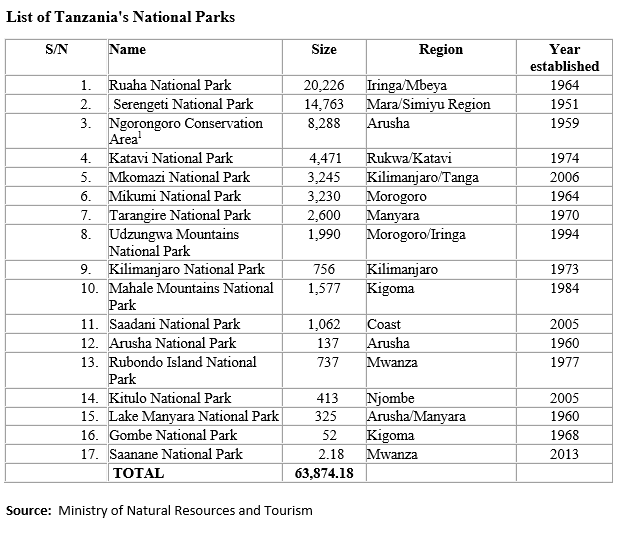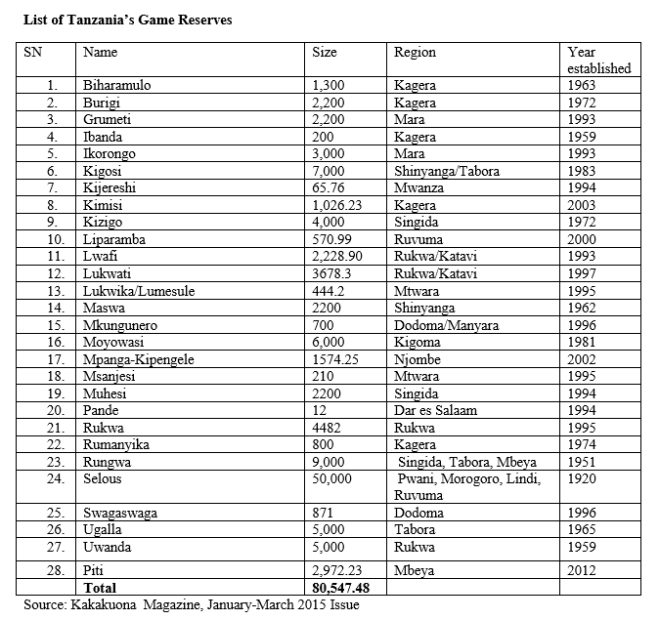
How Did We Get Here? Why Have Elephants Become a Menace at Low Numbers?
We got to where we are with the elephant and other human and wildlife conflicts because, in simple terms, the authorities entrusted with the management of wildlife have not been doing their job as they should. More specifically, wildlife authorities have not been applying appropriate wildlife management strategy to prevent the problem from occurring.
The wildlife management strategy in Tanzania has generally been to let nature take its course, while focusing on protecting wildlife from poaching. This strategy dates back to the era of preservation, which is more than a century ago, and before the conservation idea was born around 1910. However, even this is just a more convenient date to mark the beginning of conservation as a specialized natural resource management discipline and movement based on properly articulated and universally agreed on concept embracing protection, as well as wise use. The latter implies application of animal harvest strategy. Application of habitat manipulation strategy is implied in the definition for environmental conservation as published in the World Conservation Strategy of 1982.
However, the actual beginnings of management of wildlife by applying animal harvest and/or habitat manipulation strategies date back to Biblical times (in the Moses’ Law) and the Mongol Republic in the 13th Century, respectively. This means letting nature take its course as a way of “managing” wildlife in this day and age is terribly outdated.
Letting nature take its course when animal and human populations are growing on fixed land is simply untenable. History has taught us that when animal populations are left to grow indefinitely in a fixed area without hunting/cropping, as was the often-quoted classic case of the Kaibab Forest deer in North-Central Arizona, USA, pretty soon “they will eat themselves out of house and home”, and the population will ultimately crush; that is, die en masse. Incidents like this happen when movement of animals is restricted by some physical barrier. The situation for the elephants in Tanzania is basically different, their movement are virtually unrestricted.
Indeed, for a long time, Tanzania has had large areas of protected areas and open areas that allow unrestricted movement to elephants. When elephants find themselves in areas where they cannot find enough food, water and cover, they move on freely in search of what they need. When in search of their needs, protected area boundary beacons, or those of farmland do not deter elephants from pursuing what they need. This is usually a seasonal event, occurring mainly during the dry season.

What is making this (2021) year’s HEC worrisome is not just the magnitude of the problem as described above, but also the fact that this time the elephant raids are occurring during the rainy season when food and water should not be a problem. The major problem then seems to be more like habitat shrinkage than food and water shortages. This means the protected areas of origin and associated buffer zones have been reduced in expanse such that they can no longer provide sufficient home range for such a big gregarious mammal as the elephant even during the rainy season. An adult elephant requires between 100-200 kg of a variety of plant material for food, depending on body size; and drinks up to 300 liters of water per day! One herd of elephants may have up to 40 individuals. As a result of habitat shrinkage, and high resource requirements, we are getting elephant migrations and raids when they are much fewer than they were 50 years ago.
Habitat Shrinkage as the Most Proximate Cause of Elephant Invasions and Damage
The question of habitat shrinkage in Tanzania is no longer academic, nor guesswork; it is real. There is now growing credible quantitative information that clearly show that the elephant habitat has shrunk tremendously over the past 50 years. The Tanzania Elephant Management Plan (TEMP) Team in its TEMP 2010-2015, for instance, quoted the African Elephant Specialist Group elephant database to have shown that elephant range in Tanzania had decreased from 458,315 sq.km in 1998 to approximately 370,000 sq.km in 2009.
However, what seems to be the most substantive loss of wildlife habitat to human use is the land that was officially withdrawn last year from the conservation estate through the Government’s decision to allow protected area encroachers to remain and be given ownership titles to those areas. Over 750,000 acres of wildlife habitat has been lost through the exercise that involved a committee of 8 ministers appointed by the late President J. Magufuli to examine and resolve the problem of conflicts between encroaching villages and protected area authorities. Out of 975 villages that had invaded game controlled areas, 920 were allowed to stay, and the remaining 55 were reported to be under consideration. The exercise entails degazettement of 12 game controlled areas and 7 forest reserves, covering an area of 707,659 acres and 46,745 acres, respectively.
The decision to degazette those protected areas came in the wake of people’s outcry beseeching the President’s mercy, claiming they were already established, and that some had no homes to go to, and could not afford to set up new homes. According to the Minster of Lands, Housing and Human Settlements Development, who was also the Chairman of the committee of 8 ministers that carried out the exercise, the major reason for degazetting those areas is that they were found to be no longer viable for respective conservation purposes. It is worth noting that game controlled areas were gazetted in the ‘50s, but to date many have not been clearly demarcated, and have no signs of management activities, hence their vulnerability to human encroachment.
In addition to the 19 protected areas, settlements and other human activities found in the 500m buffer zones surrounding protected areas have been tentatively allowed to remain. If the national political stance remains as it was last year, and given the legal provision for “adverse property” clause, and the speed at which the Government has been handling such land matters, the occupied buffer zones will certainly ultimately be approved for human settlement. All this together amounts to a huge chunk of protected area estate to be taken away from wildlife habitat within a short span of time. This has considerable ecological impact on wildlife, especially animals with huge resource requirements like the elephant. The land withdrawn from wildlife through this exercise, together with other undocumented human encroachments, is certain to have reduced the habitat for the elephants significantly and forced them to go searching for their needs elsewhere.
The Way Forward: Instituting and Practicing Manipulative Scientific Wildlife Management Strategy
In any case, and whatever is the proximate reason for elephant migration and consequent damage to humans and their property, application of scientific research and habitat manipulation could have prevented the problem, or at least kept it at manageable level. Now, in order to prevent the crisis from worsening, and given the magnitude of the problem, the Government will do well to make coordinated and sustained efforts to ensure that available scientific research information, techniques, and ecological knowledge are being applied to contain the problem, while preventing further human encroachment on protected areas, buffer zones, and migration corridors. That is, in the short run; and it is largely the responsibility of management entities…it’s managers job.
In the long run, the wildlife policy and decision makers viz. the Wildlife Division, the Tanzania Wildlife Management Authority (TAWA), Ngorongoro Conservation Area Authority, and even Tanzania National Parks (TANAPA) need to re-orient, or rather modernize, the country’s wildlife management strategy to keep pace with ecological changes. The most important aspect of this change is to apply manipulative strategies to keep pace with changing human and wildlife dynamics, with the view to maintaining harmony between humans and wildlife. At some point this will involve training and retraining personnel, as well as changing curricula to keep pace with changing wildlife management needs.
Making the necessary change in the way wildlife is managed in Tanzania may sound complicated, involving, and costly. At the beginning it may well be all that, due to the magnitude of the problem, and having been left to grow unchecked for a long time. Sometimes all that is needed is using fire as a vegetation management tool and bored or shallow water wells as sources of drinking water during dry seasons. Generally, applying appropriate management techniques at appropriate time is much cheaper than the current fire-fighting techniques that are involving a number of stakeholders, including higher level leadership each time there is a fatal incident or huge conflict, many of whom contribute no substantive value to the solution.
Interestingly, our political leaders have on a couple of occasions hinted at the need to apply manipulative scientific wildlife management, without calling it such. Several years ago, elephants “disappeared” from Ruaha National Park, and in another instance, hippos were over crowded in mad pools and died in large numbers in Katavi National Park, and it was the late President John Magufuli and former Prime Minister Mizengo P. Pinda who identified the causes of the problems and suggested that water wells be dug for the animals during dry season to prevent mass die offs and migration. In one occasion the Late President Magufuli ordered park stuff to deliver water to the hippo pools and construct an artificial water trough for the animals. And last year the late President Magufuli reintroduced game harvesting, which, if done appropriately will contribute to the harvest strategy needed to control animal populations.
To cap it all, human-elephant conflicts in Tanzania are, for the most part, due to absence of manipulative scientific wildlife management strategy, which is now long overdue, and for which there is supportive legal, institutional, and political environment; and therefore, no good reason why it should not be applied to stem the problem and, indeed, other human-wildlife conflicts.
xxxxxxxxxxxxxxxxxxxxxxxxxxxxxxxxxxxxxxxxxxxxxxxxxxxxxxxxxxxxxxxxxxxxxxxxxxxxxxxxxxxxxxxxxxxxxxxxxxxxxxxxxxxxx









